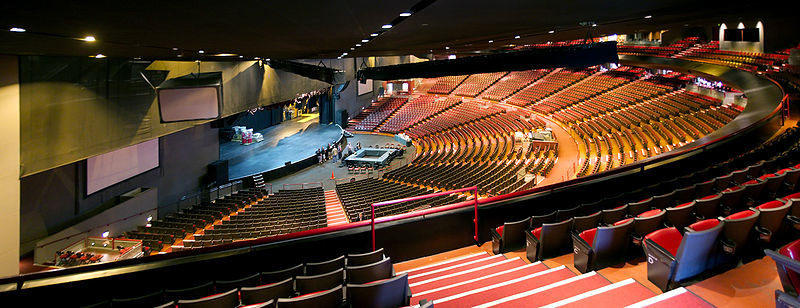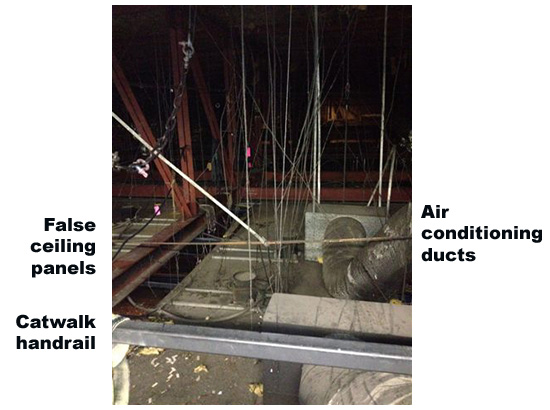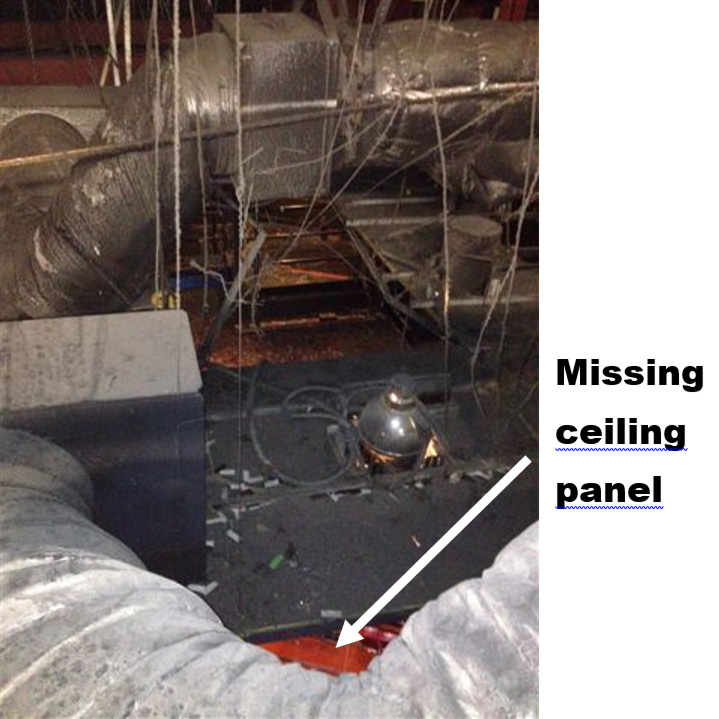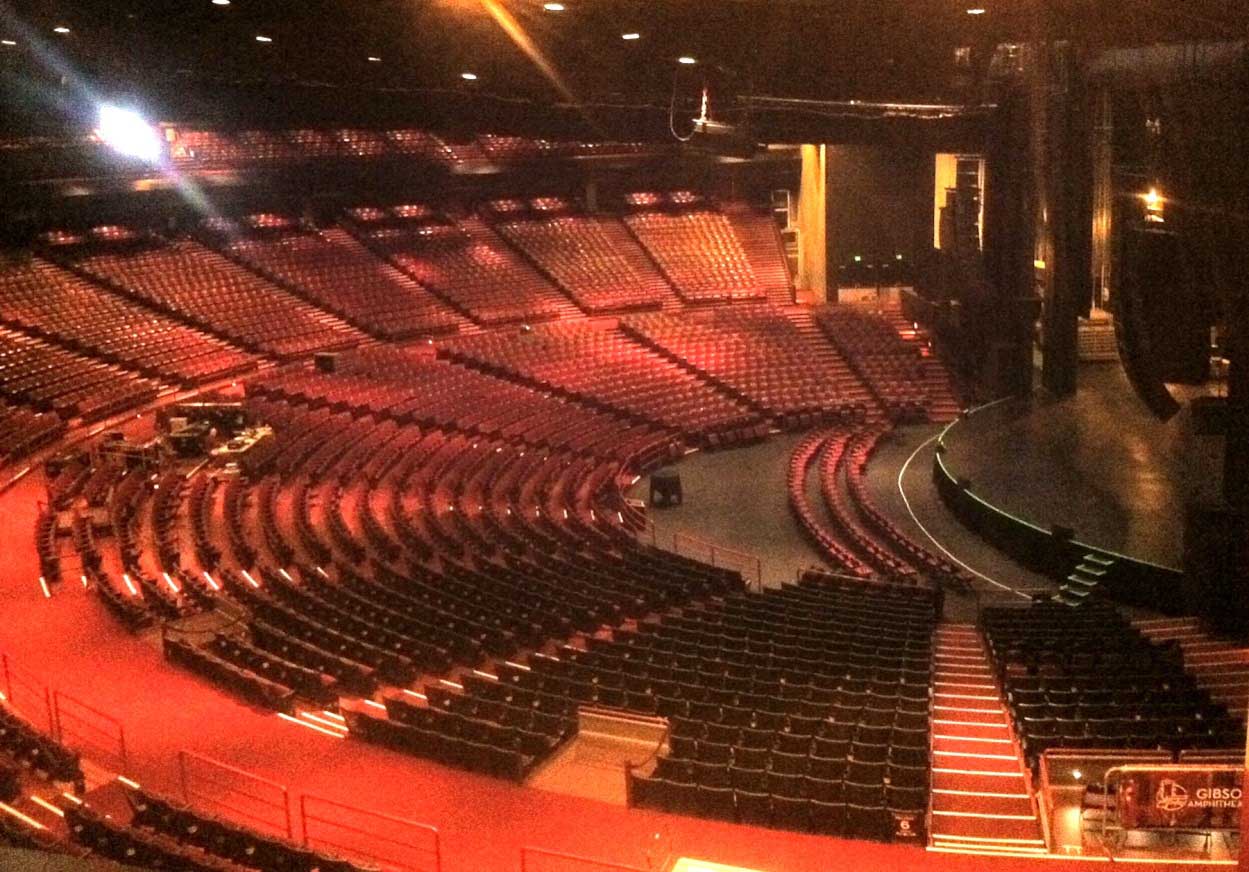Case Report: 12CA005
Stagehand falls from the ceiling of an amphitheater
Download a PDF to print this report:
Stagehand falls from the ceiling of an amphitheater (12CA005, PDF)
Summary
A stagehand died when he fell approximately 60 feet from the ceiling of an amphitheater to the floor below. The victim was removing the decorations from a recent event held at the incident scene. He climbed over the guard rail of the ceiling catwalk, walked on top of an air conditioning duct, then stepped onto a false ceiling tile to remove a suspended decoration. The false ceiling panel collapsed under his weight and he fell to the carpet-covered concrete floor below. The victim was not wearing any fall protection. His supervisor was working on the floor below. The CA/FACE investigator determined that, in order to prevent future falls, employers should ensure that:
- Employees working at elevated heights wear fall protection when necessary.
- Employees are properly supervised when working at elevated heights.
- A site-specific fall protection plan is designed and implemented for work to be performed at elevated heights.
Introduction
On Wednesday, June 6, 2012, at approximately 8:30 a.m., a 22-year-old Hispanic male stagehand died when he fell approximately 60 feet through a false ceiling panel to the floor below. The CA/FACE investigator received notification of this incident on June 8, 2012, from the Los Angeles District Office of the Division of Occupational Safety and Health (Cal/OSHA). The victim's supervisor was interviewed on August 20, 2012, and representatives from the victim's union were interviewed on August 23, 2012. On November 15, 2012, the amphitheatre where the incident occurred was visited and pictures of the incident scene were taken. Photographs from the union were also obtained. Interviews were conducted with co-workers, the victim's supervisor, and legal representatives of the amphitheater owner.
Employer
The employer of the victim was an entertainment company that was founded in 2010 and produces live concerts nationwide. The company has approximately 6,600 full-time and 13,000 part-time employees. The amphitheater is owned by a major studio in Southern California. The amphitheatre is leased to, and managed by, another public entertainment company that in turn rents the amphitheater to different production companies that produce shows and events. These production companies hire stage hands including electrical workers, riggers, carpenters, and painters from a local union. The employer cited by Cal/OSHA was the public entertainment company that leased and managed the amphitheater.
Written Safety Programs and Training
The public entertainment company had a general written injury and illness prevention program (IIPP). However, the IIPP did not address employees working at elevated heights or the training and safety factors associated with fall protection. There was not a site-specific fall protection plan for the victim or his co-workers.
Worker Information
The victim was a 22-year-old Hispanic male who was born in the United States. He had a 12th grade education and had been working as a stagehand for the past six years. He spoke both English and Spanish.
Incident Scene
The incident scene was an indoor amphitheatre that seats up to 6,089 people (3,900 on the main level and 2,189 on the mezzanine).
The amphitheater was originally built as an outdoor venue, opening in the summer of 1972. It was remodeled and converted into an indoor theatre in 1982 to improve acoustics. The venue regularly hosts concerts and major entertainment events. The ceiling above the stage is equipped with catwalks for crew members to use when accessing the ceiling area for production purposes such as electrical lighting, rigging, and decorations. The catwalks are suspended above the false ceiling of the amphitheater.
Investigation
On the day of the incident, there were approximately 70 workers in the amphitheater from the local union hall to dismantle and remove the stage, audio, visual, and decorative equipment. Each trade held a separate morning meeting with their supervisors where the workers received their job assignments. The victim, along with other riggers, was assigned by his supervisor to remove the rest of the decorations that were suspended from the amphitheater ceiling. The victim climbed up a ladder to the ceiling area and traversed a catwalk over to where banners and streamers were hanging. There were sufficient anchorage points available for fall protection equipment. He then climbed over the top railing of the catwalk and walked across an air conditioning duct to reach the suspended items. The victim did not wear fall protection equipment. His supervisor was located on the floor below.
The victim stepped off the air duct and onto a false ceiling panel. The panel gave way under his weight and the victim fell approximately 60 feet to the floor below. Other workers heard the victim fall and called 911. A medical evacuation helicopter transported the victim to the trauma center at a local hospital where he died from his injuries.
Cause of Death
The cause of death according to the death certificate was multiple traumatic injuries.
Recommendations
In order to prevent future falls, employers should ensure that:
Recommendation #1: Employees working at elevated heights wear fall protection when necessary.
Discussion: In this incident, the victim was working at an elevated height of approximately 60 feet. Although the victim had a fall protection harness up in the ceiling area, he did not use this or tie off when he left the catwalk and walked over to remove the decorations. In addition, the victim walked on surfaces (duct work and the false ceiling) which were not designed to withstand his body weight. All workers must use approved personal fall restraint (PFR) or personal fall arrest (PFA) systems at elevations exceeding 15 feet above ground or whose work exposes them to falling in excess of 7½ feet from a structure or opening to the floor level below and where temporary guardrail protection is impractical.
A PFR system is used to prevent an employee from falling. It consists of anchorages, connectors, and a body belt or harness. It may include lanyards, lifelines, and rope grabs designed for that purpose. A PFA system is used to stop an employee during a fall from a working level and to keep him or her from hitting a lower level or structure. The system consists of an anchorage, connectors, and a body harness. It may include a lanyard, a lifeline, a deceleration device, or suitable combinations of these. If a PFA system is used, it must meet the following requirements:
- It must limit the maximum arresting force on an employee to 1,800 lbs.
- It must be rigged such that an employee can neither free fall more than 6 feet, nor contact any lower level, and, where practicable, the anchor end of the lanyard shall be secured at a level not lower than the employee's waist.
- Anchorage points must be able to support 5,000 lbs. per employee attached or:
(1)Must be designed, installed, and used as part of a complete PFA system with a safety factor of two; and
(2)Under the supervision of a qualified person.
- The PFA system lifeline must meet the following requirements:
(1)It must be able to support 5,000 lbs.
(2)Each employee must be attached to a separate lifeline.
(3)The lower end of the vertical lifeline must extend to within 4 feet from the ground.
(4)A horizontal lifeline system must be designed, installed, and used under the supervision of a qualified person and maintained with a safety factor of at least two.
Had either of these systems been worn by the victim, this incident could have been prevented.
Recommendation #2: Employees are properly supervised when working at elevated heights.
Discussion: In this incident, the victim met with his supervisor and the other workers at the start of the work shift to get their assignments. After assigning work, the supervisor attended to other duties on the amphitheater floor. The supervisor stated that he reminded the workers to wear their fall protection equipment when leaving the catwalk, but did not verify compliance by direct observation of the amphitheater ceiling area. When working at elevations, supervision and inspections of the workplace and observations of work practices for adherence to safety policy and procedures can identify unsafe behaviors and emerging hazards before an injury occurs. Prior to performing their work tasks, workers should be briefed on the proper work method and use of safety equipment. A risk assessment should be performed prior to work and safer work procedures established for the specific tasks. Regular, frequent, and thorough inspections, audits, and observations by the supervisor serve to enhance awareness and identify needs for further training. Close supervision and inspections of the immediate workplace also help to identify and eliminate any new or reoccurring hazards. Had the supervisor in this incident been in the amphitheater ceiling area, he may have ensured the workers wore their fall protection.
Recommendation #3: A site-specific fall protection plan is designed and implemented for work to be performed at elevated heights.
Discussion: A fall protection plan is a site-specific plan that is designed to be integrated into the Safety and Health Management System. The fall protection plan provides a systematic approach to eliminate or reduce the risk of falling from heights by ensuring that all reasonable fall protection measures and methods have been taken prior to the commencement of the work. All workplaces engaged in activities that require workers to work at heights should develop and implement a fall protection plan to ensure the safety of the workers during their course of work. The fall protection plan should be developed by a competent person and should include specific conditions faced in the work environment. Provisions must also be made for adequate supervision to ensure that the plan is being implemented at the workplace. The fall protection plan should be monitored and reviewed periodically to ensure its relevancy and effectiveness. It should also be properly documented and kept readily available at the workplace. In this incident, a specific fall protection plan was not in place that addressed the risk of removing decorations from the ceiling, and specified the appropriate type of fall protection that was required. Had a fall protection plan been in place, there may have been the appropriate training, equipment, and supervision to prevent this incident from occurring.
Exhibits

Exhibit 1. The indoor amphitheatre where the incident occurred.

Exhibit 2. The catwalk hand rail, air conditioning duct, and false ceiling panels where the incident occurred.

Exhibit 3. The area where the victim fell.

Exhibit 4. The indoor amphitheatre depicting the ceiling height.
References
California Code of Regulations - Subchapter 4
Construction Safety Orders
Article 3 - General
§1509. Injury and Illness Prevention Program
§1510. Safety Instructions for Employees
§1511. General Safety Precautions
Article 19 - Floor, Roof, and Wall Openings
§1632. Floor, Roof, and Wall Openings to Be Guarded
Article 24. Fall Protection
§1669. General.
§1670. Personal Fall Arrest Systems, Personal Fall Restraint Systems and Positioning Devices.
§1671. Safety Nets.
§1671.1. Fall Protection Plan.
§1671.2. Controlled Access Zones and Safety Monitoring Systems.
(NIOSH) Publication Number 2004-156: Preventing Falls of Workers through Skylights and Roof and Floor Opening
Acknowledgement
The CA/FACE team would like to thank and acknowledge the Beverly Hills Police Department and The International Alliance of Theatrical Stage Employees (IATSE), Local 33, for their cooperation and assistance with this report.
Authors
Hank Cierpich, FACE Investigator
Robert Harrison, MD, MPH, FACE Project Officer
Laura Styles, MPH, Research Scientist
April 30, 2014